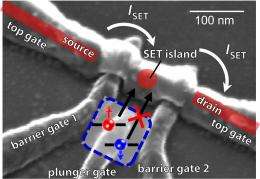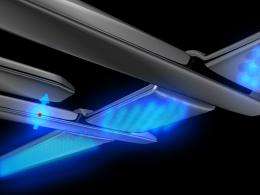Single electron reader opens path for quantum computing

Researchers from University of New South Wales (Australia), University of Melbourne (Australia), and Aalto University (Finland) have succeeded in demonstrating a high-fidelity detection scheme for the magnetic state of a single electron, that is, the spin. The research results have just been published in Nature.
A team led by UNSW engineers and physicists have developed one of the key building blocks needed to make a quantum computer using silicon: a "single electron reader".
Quantum computers promise exponential increases in processing speed over today’s computers through their use of the “spin”, or magnetic orientation, of individual electrons to represent data in their calculations.
In order to employ electron spin, the quantum computer needs both a way of changing the spin state (write) and of measuring that change (read) to form a qubit - the equivalent of the bits in a conventional computer.
In creating the single electron reader, a team of engineers and physicists led by Dr Andrea Morello and Professor Andrew Dzurak, of the School of Electrical Engineering and Telecommunications at UNSW, has for the first time made possible the measurement of the spin of one electron in silicon in a single shot experiment. The team also includes researchers from the University of Melbourne and Aalto University in Finland.
“Our device detects the spin state of a single electron in a single phosphorus atom implanted in a block of silicon. The spin state of the electron controls the flow of electrons in a nearby circuit,” said Dr Morello, the lead author of the paper, Single-shot readout of an electron spin in silicon.
“Until this experiment, no-one had actually measured the spin of a single electron in silicon in a single-shot experiment.”
By using silicon—the foundation material of conventional computers—rather than light or the esoteric materials and approaches being pursued by other researchers, the device opens the way to constructing a simpler quantum computer, scalable and amenable to mass-production.
The team has built on a body of research that has put Australia at forefront of the race to construct a working quantum computer. In 1998 Bruce Kane, then at UNSW, outlined in Nature the concept for a silicon-based quantum computer, in which the qubits are defined by single phosphorus atoms in an otherwise ultra-pure silicon chip. The new device brings his vision closer.
“We expect quantum computers will be able to perform certain tasks much faster than normal computers, such as searching databases, modelling complex molecules or developing new drugs,” says co-author Prof Andrew Dzurak. “They could also crack most modern forms of encryption.”
“After a decade of work trying to build this type of single atom qubit device, this is a very special moment.”
Now the team has created a single electron reader, they are working to quickly complete a single electron writer and combine the two. Then they will combine pairs of these devices to create a 2-bit logic gate - the basic processing unit of a quantum computer.

Qubits replace bits in a quantum computer
The qubit is the abstract quantum counterpart of the classical bit 0 or 1 in the computers today. The spin of an electron is an ideal candidate for a qubit since it has exactly two independent states. The difference to a classical bit is that the qubit can be simultaneously in states 0 and 1 rendering it conceptually more general.
To achieve the envisioned quantum computing, one has to be able to initialize and measure the states of the qubits, rotate the single-qubit states arbitrarily, and to make a certain operation involving at least two neighboring qubits—all this with high fidelity. In the work reported now in Nature, the researchers were able to initialize the spin and measure it with 92% fidelity. Thus only single spin rotations and controllable spin-spin interactions are left for the future research. After achieving these goals, the demonstration of large-scale quantum computer would be at hand.
More information: Single-shot readout of an electron spin in silicon, Nature advanced online publication, 26 September 2010 DOI:10.1038/nature09392
Provided by University of Melbourne




















